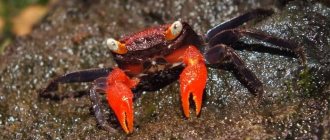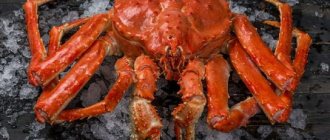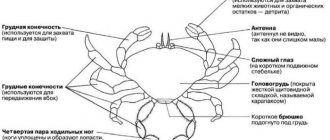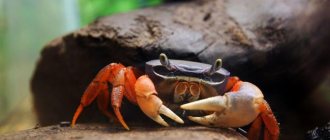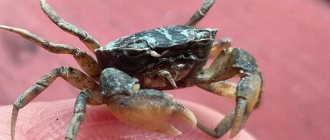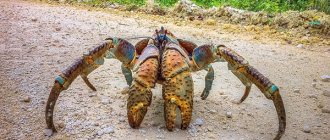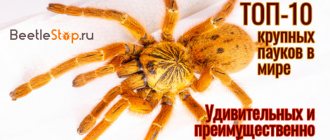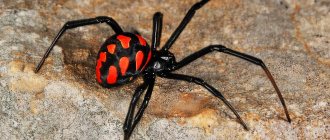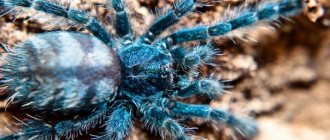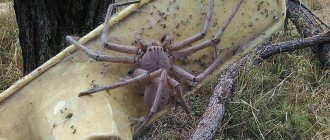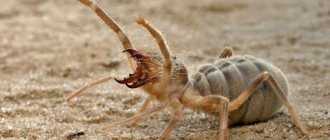- Wild animals
- >>
- Crustaceans
The giant spider crab is the largest known species and can live up to 100 years. The Japanese name for the species is taka-ashi-gani, which literally means “high-legged crab.” Its bumpy shell blends into the rocky ocean floor. To enhance the illusion, the spider crab decorates its shell with sponges and other animals. Although these creatures scare many with their spider-like appearance, they are still an amazing and fascinating wonder hidden in the deep ocean.
Origin of the species and description
Photo: Spider Crab
The Japanese spider crab (タカアシガニ or "long-legged crab"), or Macrocheira kaempferi, is a species of sea crab native to the waters around Japan. It has the longest legs of any arthropod. It is a fishery item and considered a delicacy. Two fossil species have been discovered belonging to the same genus, ginzanensis and yabei, both found during the Miocene period in Japan.
Video: Spider Crab
There was much controversy during the classification of the species based on larvae and adults. Some scientists support the theory of a separate family for this species and believe that further research is needed. Today the species is the only known surviving member of the Macrocheira, and is considered one of the earliest branching members of the Majidae. For this reason, it is often called a living fossil.
In addition to one extant species, a number of fossils are known to have once belonged to the genus Macrocheira:
- Macrocheira sp. — Pliocene Takanabe Formation, Japan;
- M. ginzanensis - Miocene form of ginzan, Japan;
- M. Yabei - Miocene Yonekawa Formation, Japan;
- M. teglandi - Oligocene, east of Twin River, Washington, USA.
The spider crab was first described in 1836 by Coenraad Jacob Temminck under the name Maja kaempferi, based on material collected near the artificial island of Dejima by Philipp von Siebold. The specific epithet was given in memory of Engelbert Kaempfer, a naturalist from Germany who lived in Japan from 1690 to 1692. In 1839 the species was placed in a new subgenus, Macrocheira.
This subgenus was elevated to genus in 1886 by Edward J. Myers. The spider crab (M. kaempferi) has been placed in the family Inachidae, but does not fit neatly into this group, and it may be necessary to create a new family exclusively for the genus Macrocheira.
Habitat
The mangrove forests of Southeast Asia are the natural habitat of red mangrove crabs. High and low tides occur frequently in this area. After the water recedes, the crabs happily swarm in the soil in search of tasty treats and seafood. In these places, the water has low salinity, as ocean waters mix with river waters.
Little bullies are excellent orderlies - they crawl along the shores of beaches and pick up everything that is left after people have rested, or has been washed onto land by water.
Appearance and features
Photo: Animal crab spider
The Japanese giant spider crab, although not the heaviest in the underwater world, is the largest known arthropod. A well-calcified carapace is only about 40 cm, but the total length of adults can be almost 5 meters from one tip of the cheliped (claw with claws) to the other when stretched. The shell has a round shape, and closer to the head it is pear-shaped. The entire crab weighs up to 19 kg - second only to the American lobster among all living arthropods.
Females have a wider but smaller belly than males. Spiny and short tubercles (growths) cover the carapace, which varies from dark orange to light brown. It does not have a mysterious coloration and cannot change color. The continuation of the shell on the head has two thin spikes protruding between the eyes.
The shell tends to remain the same size throughout adult life, but the claws lengthen significantly as the crab ages. Spider crabs are known for having long, thin limbs. Like the shell, they are also orange, but can be spotted, with spots of both orange and white. Walking claws end in inwardly curved movable parts at the tip of the walking limb. They help the creature climb and cling to rocks, but do not allow the creature to lift or grab objects.
In adult males, the chelipeds are much longer than any of the walking legs, with the right and left claw-bearing chelipeds being the same size. On the other hand, females have chelipeds that are shorter than other walking limbs. The merus (upper leg) is slightly longer than the palm (the part of the leg that contains the fixed part of the claw), but is comparable in shape.
Although the legs are long, they are often weak. One study reported that nearly three-quarters of these crabs are missing at least one limb, most often one of the first walking legs. This is because the limbs are long and poorly connected to the body and tend to be torn off by predators and nets. Crab spiders can survive without up to 3 walking legs. Walking legs can grow back during the next molt.
Anatomy[edit]
Macrocheira kaempferi
is a giant crab with a pear-shaped shell that measures 350 mm when measured along the midline. [21] Its surface is covered with small projections or tubercles. The spine of an adult giant crab is short and curves outward at the end. On the other hand, the spines of young giant crabs are long compared to their shell, along with a non-curved spine. [21] This proportionality explains, as in other decapod crustaceans, that the size of the spines decreases as individuals mature. [21]As mentioned in the taxonomic section, this genus contains the primitive feature of a family of motile antennae in the basal segment. However, "the development of a spine at the posterior angle of the supraorbital eaves and the presence of an intercalated spine and antennular septum seem to assign this genus a rather high position." Finally, there are differences between the sexes. Adult males have very long front legs where the claws are located, but they are still shorter than the walking legs of females, located at the back of the shell and used for locomotion. [21]
Where does the spider crab live?
Photo: Japanese spider crab
The habitat of the Japanese arthropod giant is limited to the Pacific side of the Japanese Honshu Islands from Tokyo Bay to Kagoshima Prefecture, usually at a latitude of 30 to 40 degrees north. They are most often found in Sagami, Suruga and Tosa bays, as well as off the coast of the Kii Peninsula.
The crab has been found as far south as Su-ao, in eastern Taiwan. This is most likely a random event. It is possible that a fishing trawler or extreme weather helped move these individuals much further south than their home range.
Japanese spider crabs most often live on the sandy and rocky bottom of the continental shelf at depths of up to 300 meters. They like to hide in vents and holes in the deep parts of the ocean. Temperature preferences are unknown, but spider crabs are regularly found at depths of 300 m in Suruga Bay, where water temperatures are around 10°C.
It is almost impossible to meet a spider crab because it wanders in the depths of the ocean. Based on research in public aquariums, spider crabs can tolerate temperatures of at least 6–16°C, but are comfortable at 10–13°C. Juveniles tend to live in shallower areas with warmer temperatures.
General information
The red mangrove crab is a small tropical crustacean. In its natural environment it can be found among the mangroves of Southeast Asia.
For a comfortable life, little bullies need water, but you need to know that they spend a lot of time on land. In their habitats, crabs live in brackish water, so it is a mistake to call crustaceans freshwater. But in aquaterrariums, mangrove crabs can swim safely in fresh water.
What does a spider crab eat?
Photo: Large spider crab
Macrocheira kaempferi is an omnivorous scavenger, consuming both plant matter and animal parts. It is not an active predator. Basically, these large crustaceans tend not to hunt, but rather crawl and collect dead and decaying matter along the seabed. By their nature they are detritivores.
The spider crab's diet includes:
- small fish;
- carrion;
- aquatic crustaceans;
- marine invertebrates;
- seaweed;
- macroalgae;
- detritus.
Sometimes they eat algae and live shellfish. Although giant spider crabs move slowly, they are able to hunt small marine invertebrates that they can easily catch. Some individuals clean the ocean floor of decaying plants and algae, and some open mollusk shells.
In earlier times, sailors told frightening stories of how a terrible spider crab would drag a sailor underwater and feast on his flesh in the depths of the ocean. This is considered untrue, although it is likely that one of these crabs could feast on the dead body of a sailor who had drowned earlier. The crustacean has a gentle character, despite its fierce appearance.
The crab has been known to the Japanese for a long time because of the damage it can do with its strong claws. It is often caught for food and is considered a delicacy in many regions of Japan and other parts of the world.
Behavior
In the ocean, arthropods become easy prey for squids and octopuses. The constant proximity of predators forces the crab to come up with new ways to survive. For this he is called a smart creature. He behaves very carefully, pays attention to little things that signal the appearance of an enemy. Deep-sea “spiders” are able to hide perfectly in any conditions. Some individuals grow tubercles containing poison on their shells, which paralyze aggressors.
In aquariums, oceanariums, natural museums and nature reserves, where animals are cared for and food is supplied, arthropods are friendly and do not cause harm. This confirms the crab’s ability to learn and indicates that the animal adequately perceives the world around it and is able to adequately assess risks.
Features of character and lifestyle
Photo: Sea spider crab
Spider crabs are very quiet creatures that spend most of their days searching for food. They wander along the seabed, moving easily over rocks and potholes. But this sea animal cannot swim at all. Crab spiders use their claws to tear apart objects and attach them to their shell. The older they get, the larger their size. These spider crabs shed their shells, and new ones grow even larger as they age.
One of the largest spider crabs ever caught was only forty years old, so there's no telling what size they might be when they reach 100 years old!
Little is known about how spider crabs communicate with each other. They often forage alone and there is little contact between members of this species, even when isolated and kept in aquariums. Because these crabs are not active hunters and do not have many predators, their sensory systems are not as acute as those of many other decapods from the same region. In Suruga Bay, at a depth of 300 meters, where the temperature is about 10°C, only adult individuals can be found.
The Japanese variety of crabs belongs to the group of so-called “decorator crabs”. These crabs are so named because they collect various objects in their environment and cover their shells with them as camouflage or protection.
Diet
Crabs need to be fed both animal and plant foods.
They willingly eat:
- pieces of fruit: melon, banana, peach;
- leafy vegetables;
- zucchini, cucumbers;
- raspberries;
- seaweed;
- leaves of aquatic plants.
The following are used as animal feed:
- pieces of krill and squid;
- sea fish;
- mussels;
- pieces of boiled chicken;
- bloodworm, coretra, tubifex.
You can feed granular or tableted commercial food for crustaceans.
Professionals provide food rich in calcium so that the external skeleton is strong. The best option would be grasshoppers. They contain, in addition to a large amount of protein, chitin, which is necessary for building the shell of crustaceans.
It is recommended to give food at least 1 time per day; it is better to divide the volume into 2-3 portions and give it in parts so as not to pollute the water with uneaten leftovers. If only crabs live in the aquaterrarium, it is better to place pieces of food on land.
Social structure and reproduction
Photo: Red spider crab
At 10 years old, the spider crab becomes sexually mature. Japanese laws prohibit fishermen from catching M. kaempferi during the early spring mating season, January to April, to preserve natural populations and allow the species to spawn. Giant spider crabs mate once a year, seasonally. During spawning, crabs spend most of their time in shallow water about 50 meters deep. The female lays 1.5 million eggs.
During incubation, females carry the eggs on their back and lower body until they hatch. The mother stirs the water with her hind legs to oxygenate the eggs. After the eggs hatch, parental instincts are absent, and the larvae are left to fend for themselves.
Female crabs carry fertilized eggs attached to their abdominal appendages until tiny planktonic larvae hatch. The development of planktonic larvae is temperature dependent and takes 54 to 72 days at 12–15 °C. During the larval stage, young crabs do not resemble their parents. They are small and transparent, with a round, legless body that drifts as plankton on the surface of the ocean.
This species goes through several stages of development. During their first moult, the larvae slowly drift toward the seabed. There the cubs rush in different directions until they click on the spikes on their shell. This allows the cuticles to move until they are released.
The optimal rearing temperature for all larval stages is 15-18°C, and the survival temperature is 11-20°C. The first stages of larvae can be observed in shallower depths, and then the growing individuals move to deeper waters. The survival temperature of this species is much higher than that of other decapod species in the region.
In the laboratory, under optimal growth conditions, only about 75% survive the first stage. At all subsequent stages of development, the number of surviving cubs decreases to approximately 33%.
Links[edit]
- ^ a b c d Peter K.L. Ng; Daniel Guino and Peter J. F. Davey (2008). "Systema Brachyurorum: Part I. An Annotated List of Extant Brachyuroran Crabs of the World" (PDF). Raffles Zoological Bulletin
.
17
: 1–286. Archived from the original (PDF) on 06/06/2011. - ^ abc Clark, Paul F.; Webber, W. Richard (October 1991). "Redescription of Macrocheira kaempferi (Temminck, 1836) zoeas with discussion of the classification of Majoidea Samouelle, 1819 (Crustacea: Brachyura)". Journal of Natural History
.
25
(5):1259–1279. DOI: 10.1080/00222939100770781. ISSN 0022-2933. - ^ abcd "Macrocheira kaempferi" . Crabs of Japan
. Marine Species Identification Portal. Retrieved March 29, 2010. - ^ abc G. F. Mies (1957). "Over het belang van Temminck's" Discours Préliminaire "voor de zoologische nomenclatuur" [On the importance of Temminck's "Discours Préliminaire" for zoological nomenclature]. Zoologische Mededelingen
(in Dutch).
35
(15): 205–227. on dit, que ce Crustacé est redouté des Hournts par les, qu'il est en état de faire au moyen de ses fortes serres - ^ ab Riebel, William. "Macrocheira kaempferi". Animal Diversity Network
. Retrieved March 9, 2022. - McClain, Craig R.; Balk, Megan A.; Benfield, Mark S.; Branch, Trevor A.; Chen, Catherine; Cosgrove, James; Dove, Alistair DM; Gaskins, Lindsay C.; Helm, Rebecca R. (January 13, 2015). "Sizes of ocean giants: patterns of intraspecific size variation in marine megafauna". PeerJ
.
3
: e715. DOI: 10.7717/peerj.715. ISSN 2167-8359. PMC 4304853. PMID 25649000. - Maurice Burton and Robert Burton (2002). "Spider Crab." International Wildlife Encyclopedia (3rd ed.). Marshall Cavendish. pp. 2475–2476. ISBN 978-0-7614-7266-7.
- ^ abc "Japanese spider crabs arrive at the aquarium". Oregon Coast Aquarium
. Retrieved March 29, 2010. - ↑
Okamoto, Kazutoshi (01/05/2009).
"Molt of the giant spider crab Macrocheira kaempferi in captivity" (PDF). Bulletin of the Shizuoka Prefectural Fisheries Research Institute
. Vol. 43: 67–70 - via Aquatic Sciences and Fisheries Abstracts (ASFA) 1: Biological Sciences and Living Resources. Check date values in: |date=(help) - Aquarium, Tennessee. "Giant Japanese Spider Crab - Tennessee Aquarium". www.tnaqua.org
. Retrieved April 6, 2022. - ^ abcd Wixten, Mary K. (1993). "A review and model of decoration behavior of spider crabs (Decapoda, Brachyura, Majidae)". Crustaceans
.
64
(3):314–325. DOI: 10.1163/156854093X00667. ISSN 0011-216X. JSTOR 20104855. - ^ abcd "Japanese Spider Crab". Georgia Aquarium. Archived from the original on October 4, 2013. Retrieved June 6, 2013.
- ^ ab "Japanese Spider Crab Care Guide" (PDF). AZA Aquatic Invertebrate Taxa Advisory Group
. Silver Spring, MD: Association of Zoos and Aquariums. 2014. Archived from the original (PDF) on September 8, 2015. Retrieved February 23 +2016. - Okamoto, Kazutoshi (1995). "Pre-zoom stage of the giant spider crab Macrocheira kaempferi (Crustacea, Decapoda, Majidae)". Fishery
.
61
(1): 161–162. DOI: 10.2331/fishsci.61.161. ISSN 0919-9268. - ^ B s d e e Kazutoshi Okamoto (1993). "Effect of temperature on the survival and growth of larvae of the giant spider crab Macrocheira kaempferi (Crustacea, Decapoda, Majidae)" (PDF). Nippon Suisan Gakkaishi
.
59
(3):419–424. DOI: 10.2331/suisan.59.419. Archived from the original (PDF) on July 22, 2011. - Riebel, W. (2011). "Macrocheira kaempferi". Animal Diversity Network. Retrieved June 3, 2022.
- ^ ab "Japanese giant spider crab - Macrocheira kaempferi - Taka-ahi-gani". Natural art. Archived from the original on August 23, 2011. Retrieved March 29, 2010.
- Hans G. Hansson. "Engelberg Kaempfer". Biographical etymology of the names of marine organisms
. Göteborgs Universitet. Retrieved March 29, 2010. - De Grave, Sammy; Pentcheff, N. Dean; Ahyong, Shane T.; and others. (2009). "Classification of living and fossil genera of decapod crustaceans" (PDF). Raffles Zoological Bulletin
. Suppl 21:1–109. Archived from the original (PDF) on 06/06/2011. - Macrocheira at Fossilworks.org
- ^ abcdefgh Sakai, K. (1987). "Tun Sakai (1903-1986)". Crustaceans
.
53
(2):205–209. DOI: 10.1163/156854087X00826. ISSN 0011-216X. JSTOR 20104298. - Kent E. Carpenter and Volker H. Niehm, eds. (1998). "Majidae" (PDF). Living marine resources of the western central Pacific Ocean. Volume 2: Cephalopods, crustaceans, sea cucumbers and sharks
. FAO Guide to Species Identification for Fisheries. Food and Agriculture Organization. pp. 1136–1137. ISBN 92-5-104052-4. - ^ abcde "Giant Japanese Spider Crab". Tennessee Aquarium. Retrieved June 5, 2013.
Natural enemies of the spider crab
Photo: Giant Japanese spider crab
The adult spider crab is quite large in size, so it has few predators. It lives deep, which also affects safety. Young individuals try to decorate their shells with sponges, algae or other objects suitable for camouflage. However, adults rarely resort to this method because their large size deters most predators from attacking them.
Although spider crabs move slowly, they use their claws against small predators. The armored exoskeleton helps the animal protect itself from larger predators. But even though these spider crabs are massive, they still have to watch out for the occasional predator, such as an octopus. So they really need to camouflage their huge bodies well. They do this using sponges, brown algae and other substances. Their carapace is mottled and uneven, much like a rock or part of the ocean floor.
Japanese fishermen continue to catch spider crabs even though their numbers are declining. Scientists fear its population may have declined significantly over the past 40 years. Often in animals, the larger it is, the longer it lives. Just look at the elephant, which can live for more than 70 years, and the mouse, which lives on average up to 2 years. And since the spider crab reaches sexual maturity late, there is a chance that it will be caught before it reaches it.
Population
Over the past half century, the number of spider crabs has greatly decreased. This is caused by overharvesting of animals. In Japanese cuisine, the animal is highly valued as a healthy and tasty delicacy. They like to be placed in aquariums in restaurants. Scientists are fighting to preserve the population of the species and use the method of artificially rearing young individuals in various fish farms in Japan.
For cooking, only young crabs that have not given birth are used. Their meat has a delicate taste and is very soft. They are used as exotic interiors.
What to do if you are bitten
Sidewalk spiders are not dangerous to humans, but their bite is still unpleasant due to the following symptoms:
- redness, swelling, itching and burning of the bite site;
- headache;
- dizziness;
- weakness.
If you are bitten by a sidewalk spider, it is enough to apply ice to the wound and take antihistamines. The bite site can be treated with “Star” balm or Fenistil-gel.
We often mistake spiders for ordinary insects, but this is wrong. They have poisonous glands containing toxins at their disposal. All types of sidewalk spiders must be handled carefully to avoid the unpleasant sensations that bites from these little ones cause.
Interesting facts about sidewalkers
- Some species have the ability to slowly change their color.
- Before mating, the male brings his lady a gift in the form of an edible insect.
- Some people specifically bring home cockroaches to get rid of cockroaches.
- Spiders are able to distinguish the sounds of music and even “dance.”
- They distinguish relatives at a distance of up to 5 meters.
- Because of their style of moving sideways, they are called crab spiders.
- Some species hunt exclusively at night, waiting for moths inside a flower.
- They do not attack insects that are much smaller in size than the spider’s body.
- Farmers move sidewalkers to their fields to get rid of pests.
- Due to the small size of the fangs, they are not able to bite through human skin.
Recommendations for a bite
Sidewalkers rarely attack humans. Their bites are not particularly dangerous, but they cause discomfort.
Symptoms of a sideworm bite:
- slight red swelling of the affected area;
- itching and burning;
- pain in the head, malaise, dizziness;
- general weakness.
For treatment, it is recommended to use ice by placing it on the affected area. Antihistamines will come to the rescue. The bite area is treated with “Asterisk” ointment. It should be remembered that this species has poisonous glands.
Varieties
Sidewalk spiders are terrestrial animals. They are found everywhere on the globe. In warm climates, species diversity is much wider than in temperate and cold climates.
Spiders adapt to climatic conditions in various ways. One of them is coloring. All varieties of bocod spiders have their own shade. This family has 170 genera, in which about 2000 species are distinguished. The most studied types are:
Flower spider (Misutnena vatia)
- color white, yellowish;
- body size up to 11 mm;
- lives on flowers of the ranunculaceae and cornflower family;
- food: butterflies, bumblebees, bees;
- Habitat: Europe, North America.
Yellow crab spider (Xisticus luctuosus)
- the body of the male is dark brown, 4-5 mm long, the female is yellow – 7-8 mm;
- lives in meadows and forest clearings;
- distributed in the European part of Russia and the former USSR.
Ornamented blueberry (Synaema ornatum)
contrasting color: the bottom of the abdomen is black, the top is red or yellow with a black angular spot;
- body length of a male is 5-6 mm, female – 7-8 mm;
- lives on flowers of the Rosaceae family;
- feeds on insects;
- lives in the steppe and forest-steppe of our country.
The corn borer is a pest of corn, millet, barley and sunflower.
